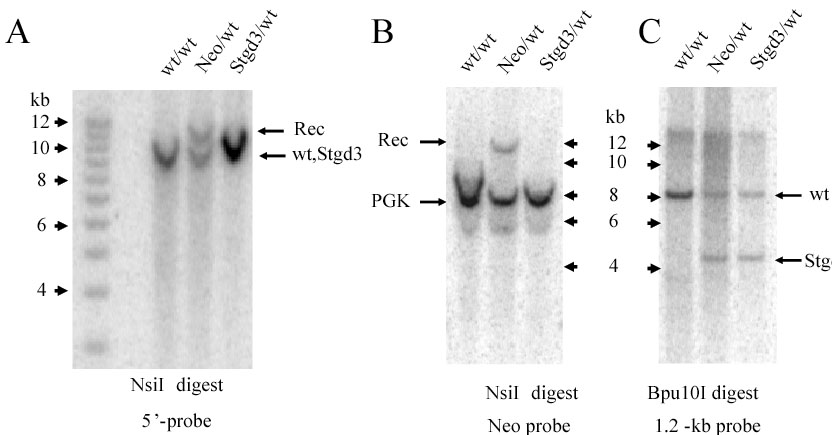![]() Figure 2 of
McMahon, Mol Vis 2007;
13:258-272.
Figure 2 of
McMahon, Mol Vis 2007;
13:258-272.
Figure 2. Southern blot verification of Stgd3 mouse genotype
A: Genomic DNA was digested with NsiI and probed with a 5'-probe located upstream of the recombinant targeted site (see Figure 1). A signal from the wt allele as well as an extra band (Rec), derived from the recombinant allele, were detected in the Neo/wt DNA digests. The size of the Rec band was consistent with the 11.8-kb size predicted for the homologous recombination event, confirming the presence of recombination in these mice. In the Stgd3/wt DNA digests, the size of the recombined band was reduced due to loss of the Neo cassette with the result that the wt and Stgd3 allele-derived signals were not resolved. B: Hybridization with the Neo probe detected the presence of the Neo signal in the Neo/wt but not in Stgd3/wt DNA digests, confirming recombination of the targeting sequence and Cre-mediated excision of the Neo cassette, respectively. The Neo probe contained a mouse phosphoglycerate kinase (PGK) promoter and thus also detected the endogenous PGK-gene sequence in all mouse DNA samples. C: Introduction of the STGD3 mutation into Elovl4 exon 6 generated a new Bpu10I restriction site in this exon. The presence of the STGD3-mutation in the DNA of Neo/wt and Stgd3/wt mice was confirmed by the detection of a new 4.3-kb Bpu10I restriction fragment that was absent from wt/wt DNA.
